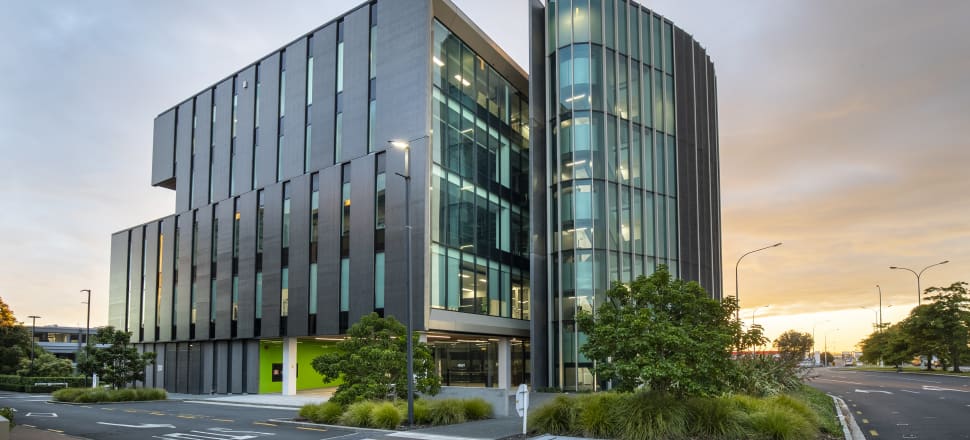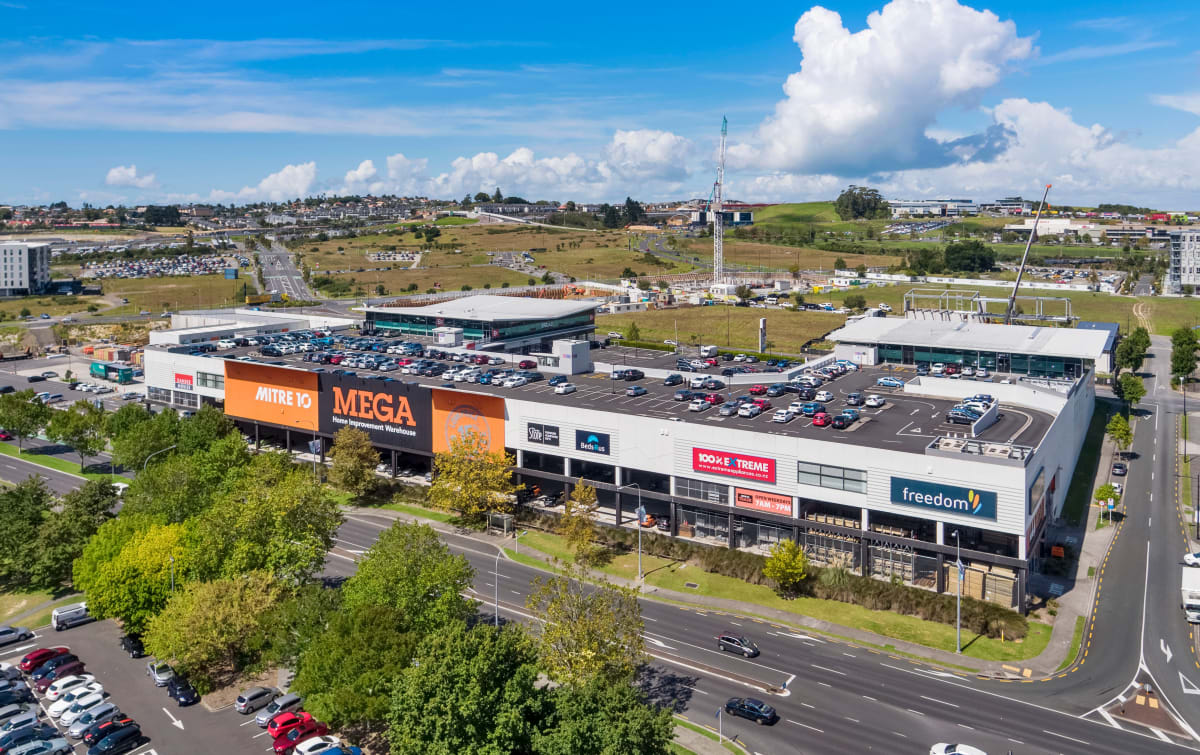
Inflation pressures and a challenging economic environment have taken a toll on the commercial property market, but Oyster Property Group sees potential for the patient investor | Content Partnership
Uncertainty in the market has been driven by a combination of a difficult economic situation that has seen the central bank take unprecedented measures to rein in inflation, the upcoming election, as well as profound shifts in the way we work, shop, live and occupy space.
Oyster Property Group chief executive Mark Schiele says property activity always slowed down when uncertainty was present and then picked back up again.
Oyster has extensive interests across retail, industrial and office property assets.
“There are two things that need to occur from a certainty perspective; one is an understanding of where inflation and interest rates are going to top out and start to reduce, and then there's certainty around government.”
Schiele says in the past 18 months the country has faced the most rapid increase in interest rates since the official cash rate was introduced.
"In the normal course of events commercial property rents have a pretty good inflationary hedge, but you just don’t get the opportunity to review your rents at the same pace as the Reserve Bank has cranked the OCR up.
There’s a massive disconnect there, and in the short term that reduces your net income because the largest cost in a property business is debt servicing.”
Rent will continue to catch up, and in mid-July the central bank signalled it thought its interest rate hikes had done their job to cut household spending and no further increases would be needed for the time being.
Election uncertainty can’t really be addressed until the polls close in October, but once it does certainty will fall into place with investors no matter which way it goes, Schiele says.
“We are seeing, probably as a result of the OCR pause and Reserve Bank rhetoric, transaction levels increase in the last month but not to huge extents.
“It’s green shoots if you like."
Oyster has been operating for more than 20 years, during which time it has successfully navigated multiple economic cycles.
Between 2003 and 2022 total returns from its exited property funds1 significantly outperformed cash term deposits2.
Schiele says this highlighted the importance of taking a long-term stance on property.
“In the near-term, things like interest rates impact, but over a longer period of time, whatever that may be, the total returns perform as they should, relative to the risks.
“Right now we're near the bottom of a cycle, with a bit more pain to go, but investment outlooks need to be longer than that.”
A future for office
Nowhere is uncertainty as present as in the office property sector, with commentary over the death of the office and the shift to working from home rife.
“Clearly there's some disruption going on offshore which is significantly impacting global sentiment, and actual returns.

“In the US in particular, there are significant office vacancy rates in many major metropolitan areas. You've had large global investors ‘hand back the keys’ to banks in those markets, which is unprecedented except for during the GFC.”
Schiele says while the issues were prevalent in America, they were also present in the UK and Europe.
“The impact in the Asia Pacific region has been far less, although capitalisation rates and liquidity – essentially those that are standing in line to buy these office buildings – have changed quite a bit because of global sentiment.”
Oyster currently doesn’t have any Auckland CBD office space in its portfolio, although it has significant city fringe and suburban office holdings, particularly office parks along Auckland’s southern corridor.
Schiele says these assets, which typically had plentiful carparks, easy access to transport links, and were closer to workers' homes, were performing well.
“We're continuing to see rental growth. The rent base is lower than what you would find in the CBD and that's another attractive feature to occupiers.”
The most recent office market research from commercial property company JLL shows office assets along Auckland’s southern corridor had a vacancy rate of just 3.7 percent (driven largely by leasing activity at Oyster’s Millennium Centre and Central Park business parks), while CBD vacancy is sitting around 10 percent.
Schiele acknowledges Oyster’s experience has been different to the global phenomenon, but the types of assets it holds aren’t completely immune, with wider sentiment issues impacting on the appetite to buy such assets and therefore the value.
He doesn’t see this sentiment sticking around for the long haul.
“Remote working, if you just use that as a proxy for why this is occurring, is not necessarily the best thing en masse for businesses.”
Schiele says many early and vocal adopters of remote working were now trying to get staff back into the office for cultural reasons, as well as creating a connection to a workplace to slow attrition and further develop talent.
“It's very hard on a Zoom call to fundamentally understand the pulse of the business.”

“I know I’m in a property company and would have an interest in saying this, but we’re hearing it from our tenants, and those people aren’t in property companies.
“In the Auckland market, it's not so much that people want to work from home, it's that the commute is quite a difficult thing. If you’re going to be sitting in your car for an hour each way and you have the opportunity not to, you’re probably thinking pretty hard about your options.”
He says that flowed into Oyster’s non-central office parks not being as impacted as much as offices in the CBD.
Industrial resilience
Industrial property has been something of a sweetheart asset class for the past 10 to 15 years, exacerbated by an uptick in demand through the pandemic, where a higher demand for goods and an increase in e-commerce coincided with a need to stockpile inventory to mitigate the broken supply chain.
Schiele sees the tailwinds behind industrial assets, including logistics facilities, continuing.
While the supply chain is operating at something like normal, the demand for greater space from retailers and importers has stuck around.
Some estimates place the amount of warehouse space needed per person in a city at four square metres, meaning significantly more industrial property will be needed in places like Auckland, where the population is expected to grow by as much as 300,000 people by 2033.

Finding the land to meet this demand could prove difficult.
“There's another dynamic operating in Auckland, we're on an isthmus, you can't create more land east or west. There's not enough locationally appropriate zoned land for logistics demand.”
He says this has led to larger industrial developments being planned to the south and north of greater metropolitan area.
“That continues to enhance demand for- centrally located industrial and logistics property, particularly those with good transport link proximity, and that demand has led to significant rent growth over the last little while.”
Schiele says high land costs and rising construction costs have been a barrier to delivering new high-quality assets for occupiers and this has also played a part in increasing industrial and logistics rents.
Conviction in retail
The same pressures driving the industrial property gold rush are also redefining what constitutes an industrial asset, with elements of large-format retail also crossing into the space.
He says through the pandemic some of the supermarkets in Oyster’s portfolio had shifted into ‘grey’ stores, closing to retail customers and operating as logistics facilities for grocery delivery.
“It really did tell the story of how versatile both large format retail properties and last mile logistics sites close to main population hubs are.”
However Oyster believes strongly in large-format retail, Schiele says.
“The view everything's going to go online, is an Armageddon view and we don't share it.”
The business also has more conventional retail property in its stable, including shopping centre assets.
After rising around 67 percent during the pandemic, online shopping has come off the boil a bit.
NZ Post half-year results released in March showed that parcel volumes had fallen back to 2019 levels, when New Zealanders spent about $4.6 billion on online shopping.
The shift to online has been damaging to some retail, Schiele says, with the brunt being worn by department stores in the US.

This had flowed through to softening yields for conventional retail even before the flight to online during the pandemic, particularly sub-regional shopping centres.
This is not necessarily the case for well-positioned properties in New Zealand, he says.
“Shopping centres continue to operate well, including assets like Dress Smart in Onehunga in our portfolio, where they are catchment dominant.”
Traditional retail next to supermarkets has also outperformed non-catchment retail.
“There's a bifurcation in the retail property asset class, but these types of catchment dominant assets continue to make good investments.”
Sustainability
Oyster has been rolling out a sustainability program for a number of years now, with 3-star and above NABERSNZ (an adaptation of the National Australian Built Environment Rating System) across its office portfolio. It is also working on building its first Green Star Design and As Built rated asset.
Schiele says the team views sustainability measures as the right thing to do, but not taking these steps will definitely have significant implications for property investment.
Debt providers and equity investors increasingly demand a pathway to carbon reduction. Occupiers are placing more importance on sustainability when considering properties, and it will also ultimately impact when securing insurance.
Taking too long to move could also see your assets become stranded, difficult to sell and unattractive to tenants with their own climate goals, he says.
“It's been embedded in our psyche for some time, we've gone through a process where we've evaluated what we might want to do in the ESG space and quite honestly, it's a very big question and the answers are very broad.
“We've been very careful to make sure that we don't set unachievable goals and but that we make continuous progress.”
“Sometimes it’s not an instant payback, but if the consequence is having nobody occupying space in five years’ the commercial merits are obvious.”
Notes
1 The realised total returns (realised income return plus realised capital return) represents a simulated total return to a hypothetical investor who purchased each of Oyster’s single asset funds that were unwound through the sale of the underlying commercial properties (earliest fund inception in 2003) with an even weighting across the funds.
2 The realised total return for new interest-bearing 6-month term deposits. Source: www.rbnz.govt.nz Note: All income returns above are not compounded, and all returns are before tax.







